Malaysia Agrochemicals Market Size
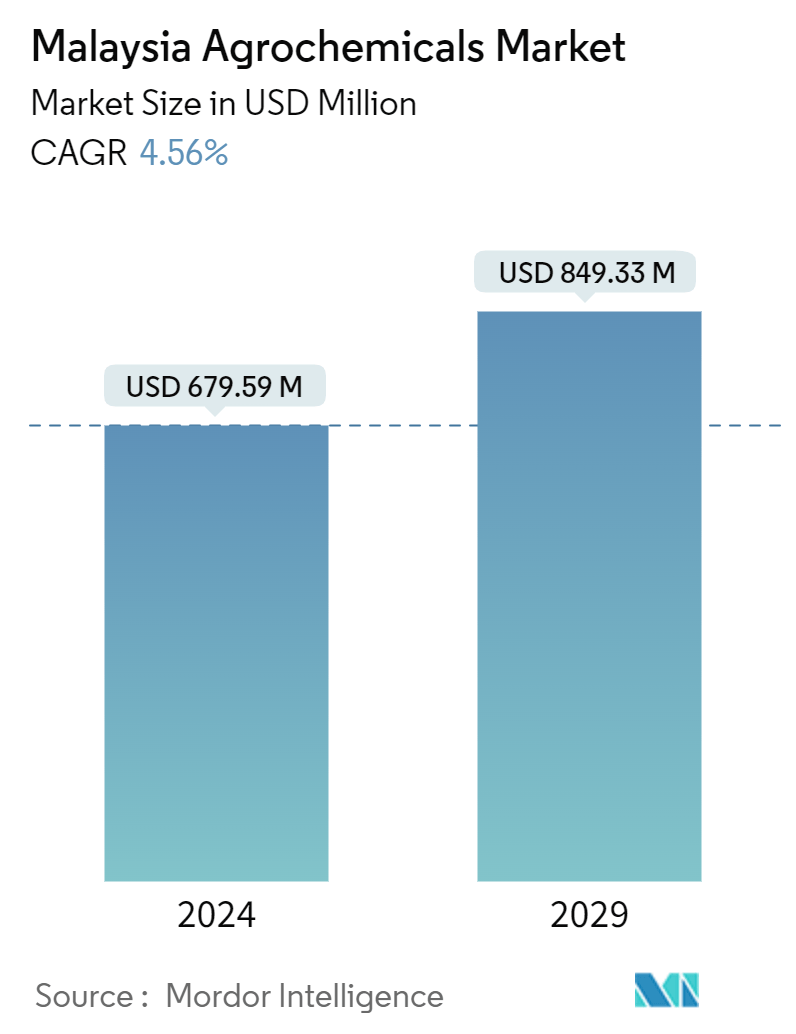
| Study Period | 2019 - 2029 |
| Base Year For Estimation | 2023 |
| Market Size (2024) | USD 679.59 Million |
| Market Size (2029) | USD 849.33 Million |
| CAGR (2024 - 2029) | 4.56 % |
| Market Concentration | Low |
Major Players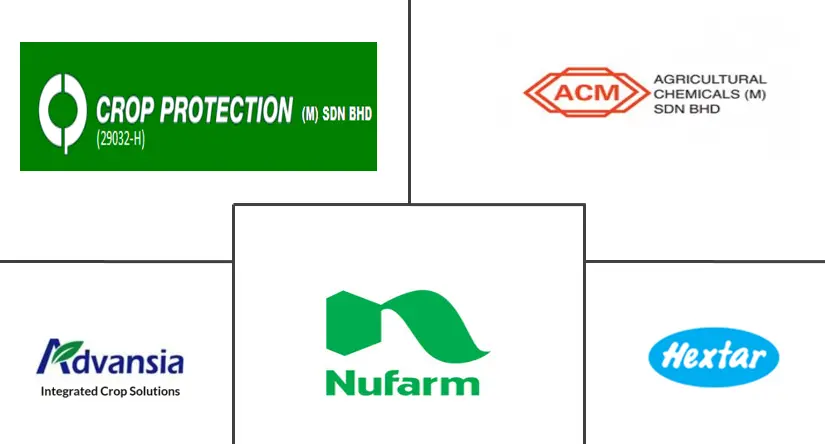
*Disclaimer: Major Players sorted in no particular order |
Malaysia Agrochemicals Market Analysis
The Malaysia Agrochemicals Market size is estimated at USD 679.59 million in 2024, and is expected to reach USD 849.33 million by 2029, growing at a CAGR of 4.56% during the forecast period (2024-2029).
Malaysia is one of the most developed markets in Southeast Asia. In 2022, the agriculture industry in Malaysia contributed 6.6% to the country's gross domestic product (GDP). In Malaysia, agriculture is an important industry, as it ensures food security and increases income levels in rural areas. Increasing population statistics and declining arable land are responsible for maintaining adequacy in agricultural practices, ensuring more significant utilization of agrochemical products in the areas that were ignored in the past.
Moreover, rice is a staple food among Malaysians and one of the most important food crops in the country. According to the Food and Agricultural Organization, in 2021, Malaysia produced 1.68 million metric tons of rice, an increase of around 180 thousand metric tons compared to the previous year. This growing production trend resulted in extensive pesticide usage to minimize pests and maximize profit.
The use of agrochemicals has been growing significantly in the country, particularly for pesticides and fertilizer consumption, as modern practices are being utilized in fields. The growth of the agrochemical industry also depends on the rapid expansion of areas under oil palm and rubber plantations. Malaysia's oil palm industry was the country's primary agricultural sector and contributed 2.4% to its overall gross domestic product (GDP) in 2022. According to the FAO, in 2021, 45,670 metric tons of pesticides were used in Malaysia for agricultural purposes, an increase from around 36,000 metric tons the year before.
Many local enterprises in Malaysia are expanding into the agricultural sector. The nation is also evolving into a regional hub for pesticide exports, as active chemicals are transferred here to be transformed into fresh goods before being reexported to surrounding countries. Additionally, the increasing government initiatives are becoming a driving factor for market growth. For instance, in 2022, the Malaysian Ministry of Agriculture and Food Industries (MAFI) was requested by Pesticide Action Network Asia Pacific (PANAP) to consider providing paddy farmers with help for safer, non-chemical pesticide alternatives that can benefit farmers' health. Therefore, the increase in consumption of highly economical crops, food demand, and government support is expected to aid market growth during the forecast period.
Malaysia Agrochemicals Market Trends
Fertilizer is the Largest Type of Agrochemicals
Fertilizers enhance the quality of crops by supplying necessary nutrients to both the crops and the soil. With a growing population putting pressure on food production, increasing agricultural output on current farmland is essential to meet the country's food needs. For instance, the population of Malaysia rose from 32.3 million in 2020 to 32.7 million in 2021, leading to a higher demand for food. Proper and judicious application of fertilizers plays a crucial role in meeting the food needs of the expanding population in the country by maximizing the productivity of arable land. As a result, fertilizers are crucial in the Malaysian agriculture sector, assisting farmers in enhancing both the quality and quantity of their harvests.
On the other hand, the rapid growth of the oil palm industry in peninsular and East Malaysia (Sabah and Sarawak) has led to the cultivation of oil palm in lower-productivity soils, such as hilly and inland soils, as well as more problematic soils like peat soil in Sarawak. In these challenging soil and climate conditions, along with varying cultivation methods, the use of fertilizers becomes increasingly crucial for achieving higher crop yields. According to the FAO, in 2022, 7.82 million metric tons of fertilizer were produced in Malaysia, an increase from around 4.80 million metric tons in 2020.
Furthermore, the Malaysian government has been providing support to the fertilizer industry through a range of initiatives to maintain production levels and promote the sector's growth in a sustainable and effective way. For instance, in 2022, the Department of Agriculture (DoA) introduced the Fertilizer Act to promote agriculture capacities. Additionally, the ARISE Plus Malaysia project is implemented by the International Trade Centre, which has provided a series of training sessions that have assisted the country in developing a full-fledged pragmatic registration framework for fertilizers that match Malaysia with the other ASEAN countries. For instance, according to the Department of Statistics Malaysia, the sales of fertilizers in 2020 were recorded at USD 1.00 billion, which increased to USD 1.32 billion in 2022. Hence, government initiatives are boosting fertilizer sales, which is expected to lead to market growth during the forecast period.
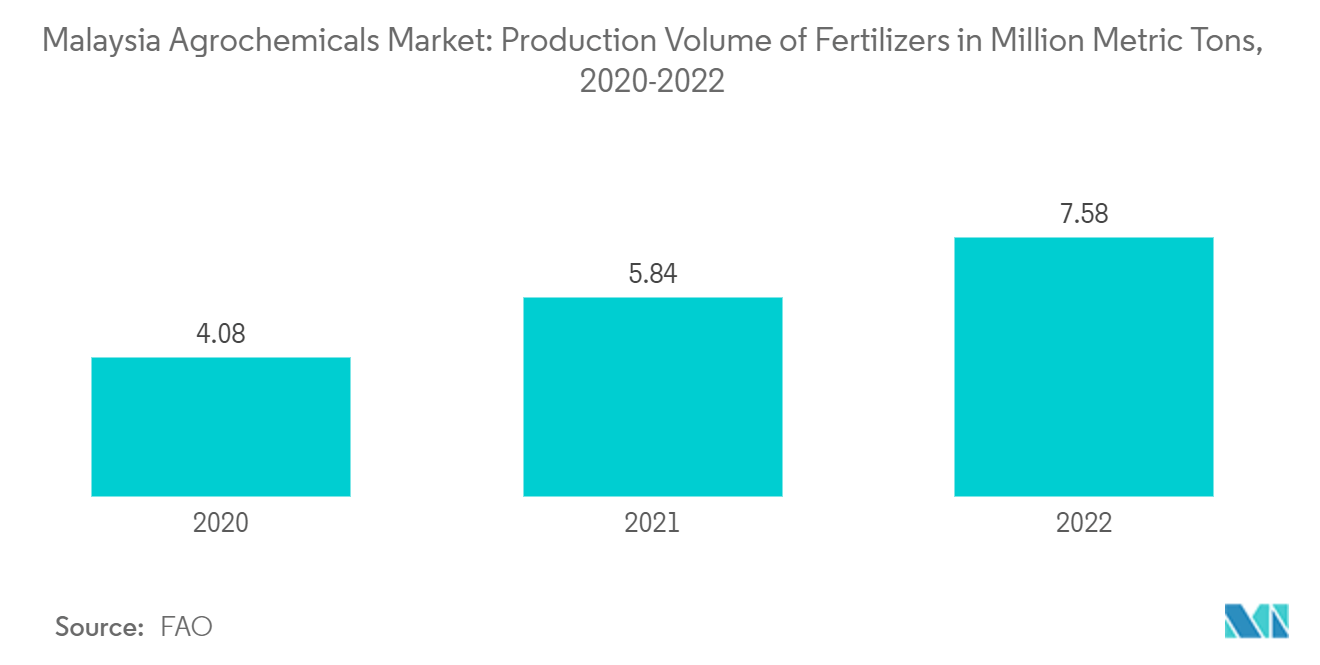
Grain and Cereals are the Largest Users of Agrochemicals
Malaysia is one of the leading cereal producers in the ASEAN region. Since cereal production is crucial for ensuring food security in a country, it is essential to increase production to meet the needs of a growing population. According to the Food and Agriculture Organization, the total cereal production increased by 4.2% between 2019 and 2021, reaching 2.5 million metric tons in 2021. This is mainly due to the increased usage of crop protection chemicals, which reduces the losses and increases production. This is focused on improving its domestic production to reduce its reliance on imported corn and wheat, increasing the demand for agrochemicals.
Rice is the primary food source for up to 60% of Malaysia's population and is the main crop grown in tropical regions. The production of rice is highly susceptible to a wide range of pests, necessitating the use of various types of pesticides to control insects, weeds, fungi, and bacteria. In Malaysia, 20% of all pesticides were used in paddy fields in 2020, as FAO estimated. Extreme drought and heat conditions help these diseases to grow. The existence of a high population with a serious infestation of these pests results in low rice yield for the farmers. The rising infestation of insects and diseases is driving the consumption of agrochemicals, which is expected to drive market growth.
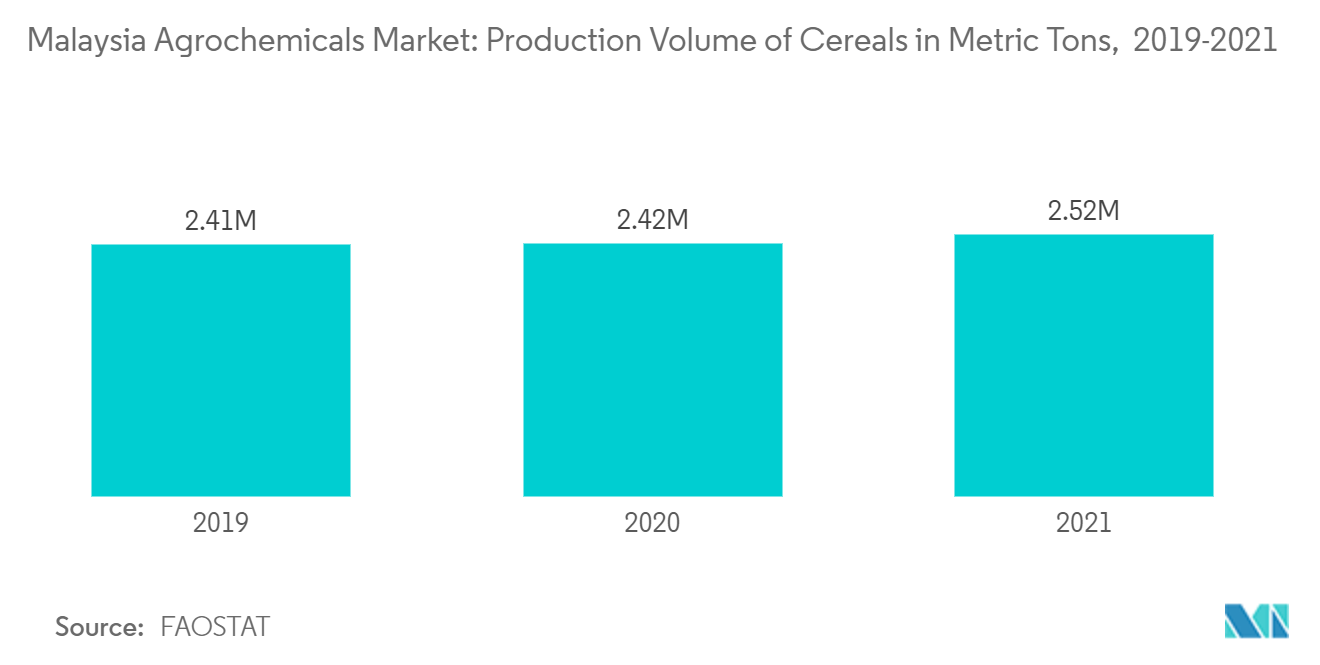
Malaysia Agrochemicals Industry Overview
The Malaysian agrochemicals market is fragmented and consists of significant players like Agricultural Chemicals (M) Sdn Bhd (ACM), Crop Protection (M) Sdn Bhd, Hextar Group, Advansia Sdn Bhd, Sin Seng Huat, and Nufarm. New product launches, mergers and acquisitions, and partnerships are the major strategies adopted by these leading companies. They are focusing on making investments in innovation, collaborations, and expansions to increase their market share.
Malaysia Agrochemicals Market Leaders
-
Crop Protection (M) Sdn. Bhd.
-
Nufarm Ltd
-
Hextar Group
-
Agricultural Chemicals (M) Sdn. Bhd. (ACM)
-
Advansia Sdn Bhd
*Disclaimer: Major Players sorted in no particular order
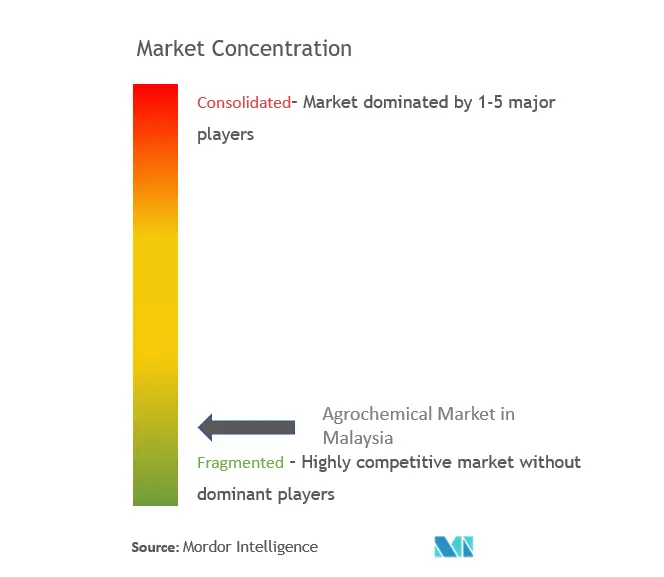
Malaysia Agrochemicals Market News
- April 2024: During the holy month of Ramzan in Malaysia, leftovers from meals were transformed into fertilizers by a state facility. Following the Ramzan fasting, individuals donated their uneaten food to a special machine designed to convert the scraps into fertilizer suitable for agricultural purposes.
- February 2023: The Rahmah Malaysia Foundation (RMF) and the Selangor State government introduced the "Rahmah Fertilizer Programme" to alleviate financial strain on farmers as part of the MADANI initiative within the Unity Government's framework. The incentive aim was to support farmers and the agricultural industry in Selangor in keeping pace with modern technological advancements.
- July 2022: Nufarm increased its investment and expanded its partnership with crop health company Enko. These funds enabled Enko to advance its product pipeline of crop protection chemistries that targeted critical pests and weeds through novel pathways.
Malaysia Agrochemicals Market Report - Table of Contents
1. INTRODUCTION
- 1.1 Study Assumption and Market Definition
- 1.2 Scope of the Study
2. RESEARCH METHODOLOGY
3. EXECUTIVE SUMMARY
4. MARKET DYNAMICS
- 4.1 Market Overview
-
4.2 Market Drivers
- 4.2.1 Recurring Instances of Pests and Diseases on Crops
- 4.2.2 Increasing Demand for Food and Agricultural Productivity
- 4.2.3 Reduction in Agricultural Land Area
-
4.3 Market Restraints
- 4.3.1 Stringent Regulations on Agrochemicals Usage
- 4.3.2 Introduction of Gene Editing Technology
-
4.4 Porter's Five Forces Analysis
- 4.4.1 Threat of New Entrants
- 4.4.2 Bargaining Power of Buyers/Consumers
- 4.4.3 Bargaining Power of Suppliers
- 4.4.4 Threat of Substitute Products
- 4.4.5 Intensity of Competitive Rivalry
5. MARKET SEGMENTATION
-
5.1 By Product Type
- 5.1.1 Fertilizers
- 5.1.2 Pesticides
- 5.1.3 Adjuvants
- 5.1.4 Plant Growth Regulators
-
5.2 By Application
- 5.2.1 Crop-based
- 5.2.1.1 Grains and Cereals
- 5.2.1.2 Oil Seeds and Pulses
- 5.2.1.3 Fruits and Vegetables
- 5.2.2 Non-crop-based
- 5.2.2.1 Oil Palm
- 5.2.2.2 Rubber
- 5.2.2.3 Turf and Ornamental Grass
- 5.2.2.4 Other Crops
6. COMPETITIVE LANDSCAPE
- 6.1 Most Adopted Straregies
- 6.2 Market Share Analysis
-
6.3 Company Profiles
- 6.3.1 Agricultural Chemicals (M) Sdn Bhd (ACM)
- 6.3.2 Crop Protection (M) Sdn Bhd
- 6.3.3 Nufarm Ltd
- 6.3.4 Hextar Group
- 6.3.5 Advansia Sdn Bhd
- 6.3.6 Sin Seng Huat
- 6.3.7 Biovista Lifesciences Sdn Bhd
- 6.3.8 Kenso Corporation
- 6.3.9 Farmcochem Group
- 6.3.10 PK Fertilizers
- 6.3.11 Central Minerals & Chemicals Sdn Bhd (CMC)
- 6.3.12 Agri Fert
- *List Not Exhaustive
7. MARKET OPPORTUNITIES AND FUTURE TRENDS
** Subject To AvailablityMalaysia Agrochemicals Industry Segmentation
Agrochemicals are chemical products, including fertilizers, adjuvants, pesticides (insecticides, herbicides, fungicides, and nematicides), and plant growth regulators, which are used in agriculture to enhance crop productivity and protect crops from pests, insects, weeds, and fungi. The Malaysian agrochemicals market is segmented by product type (fertilizers, pesticides, adjuvants, and plant growth regulators) and application (crop-based [grains and cereals, fruits and vegetables, and oilseeds and pulses] and non-crop-based [oil palm, rubber, turf ornamental grass, and other crops]). The report offers market size and forecasts in terms of value (USD) and volume (metric tons).
| By Product Type | Fertilizers | |
| Pesticides | ||
| Adjuvants | ||
| Plant Growth Regulators | ||
| By Application | Crop-based | Grains and Cereals |
| Oil Seeds and Pulses | ||
| Fruits and Vegetables | ||
| By Application | Non-crop-based | Oil Palm |
| Rubber | ||
| Turf and Ornamental Grass | ||
| Other Crops |
Malaysia Agrochemicals Market Research FAQs
How big is the Malaysia Agrochemicals Market?
The Malaysia Agrochemicals Market size is expected to reach USD 679.59 million in 2024 and grow at a CAGR of 4.56% to reach USD 849.33 million by 2029.
What is the current Malaysia Agrochemicals Market size?
In 2024, the Malaysia Agrochemicals Market size is expected to reach USD 679.59 million.
Who are the key players in Malaysia Agrochemicals Market?
Crop Protection (M) Sdn. Bhd., Nufarm Ltd, Hextar Group, Agricultural Chemicals (M) Sdn. Bhd. (ACM) and Advansia Sdn Bhd are the major companies operating in the Malaysia Agrochemicals Market.
What years does this Malaysia Agrochemicals Market cover, and what was the market size in 2023?
In 2023, the Malaysia Agrochemicals Market size was estimated at USD 648.60 million. The report covers the Malaysia Agrochemicals Market historical market size for years: 2019, 2020, 2021, 2022 and 2023. The report also forecasts the Malaysia Agrochemicals Market size for years: 2024, 2025, 2026, 2027, 2028 and 2029.
Agrochemical in Malaysia Industry Report
Statistics for the 2024 Agrochemical in Malaysia market share, size and revenue growth rate, created by Mordor Intelligence™ Industry Reports. Agrochemical in Malaysia analysis includes a market forecast outlook to 2029 and historical overview. Get a sample of this industry analysis as a free report PDF download.



